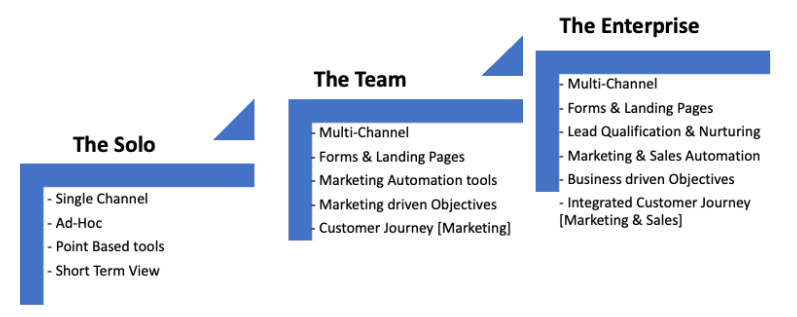Levels Of Marketing Automation Maturity

The last decade has seen a proliferation of technologies and tools in the Marketing and Sales domain. The digital landscape has exponentially increased. It is true that prospective customers are using the internet for almost everything - from conducting online research to making purchases - and that digital spending levels have increased significantly.
On the other hand, marketing professionals are also equipped [in fact, bombarded] with technologies to track and identify this behavior.
Marketing and Sales Automation Technologies
In today's dynamic world, marketing executives often need to remember the basics amidst the myriad of new tools and technologies. Even though the playground is different, the fundamentals remain the same – identify your customer, track the footprints, get introductions, nurture the leads, present a value proposition, and convert.
Marketing and Sales Automation technologies have evolved over the years to enable the above activities in the digital world. Large and small companies have started using these tools extensively to execute campaigns.
However, there is a maturity curve associated with adopting such technologies.
Having worked as an entrepreneur and marketing professional, implementing, and using various tools (Mailchimp, Pardot, Eloqua, Marketing Cloud, Hubspot, etc.) for campaign execution, I was able to study the usage patterns in the adoption of these technologies.
Based on the study, I could formulate the following three levels of marketing automation maturity :
The Solo
In this early stage, only one marketing channel is used for campaigns. Most often, it is an email marketing campaign, or a social media ad.
Planning is ad-hoc, and the campaign decision is more individualistic - either by the salesperson or the business owners themselves. They scramble through some point-based tools, write the content themselves, and push the buttons to execute campaigns. The view is very much short-term.
The Team
This level is a bit more mature than 'The Solo'. It involves a small team of executioners [designers, marketers, content writers] using a variety of marketing channels. Most digital marketing agencies fit into this category.
It is a marketing-centric level, where a small team conducts campaigns across email, social media, website visitor tracking, SMS marketing, etc. They also use landing pages and forms to integrate other channels.
The objectives are more marketing driven – such as traffic, clicks, and form-fills. A customer journey is mapped only until the boundaries of the marketing function.
The Enterprise
This is the stage where sales and marketing alignment takes place.
Planning is more oriented toward supporting business goals and objectives. Multiple channels are used for campaign execution, including sales channels.
Lead nurturing, and qualification mechanisms are developed and adopted. Automation, analytics, and CRM technologies are well integrated. A unified 360-degree view of the customer journey across marketing and sales stages is available.
Mindset and Relevance
Despite the growth of marketing automation, it should be noted that maturity is not directly proportional to the size of a company. There have been numerous instances when marketing departments in large enterprises still work in isolation. In other cases, smaller agencies have a well-integrated and mature approach to marketing.
Additionally, owning a higher number of technologies is only helpful if it provides both micro and macro benefits. A more progressive mindset is needed to move up the maturity levels, and hence the focus on first principles is essential in today's digital marketing era.
This article was contributed by our expert Girish Bendigiri
Frequently Asked Questions Answered by Girish Bendigiri
Q1. What are some marketing automation trends predictions you foresee?
Data will be the key to driving decisions. Analytics will be an essential area in Marketing Automation. Also, AI will play a significant role in deciding campaign flows. Another trend is the integration of various channels to provide a unified customer view.
Q2. What is the importance of digital marketing for the success of a business?
There has been an exponential increase in the digital population in B2B and B2C. And the global pandemic has accelerated digital adoption. Hence, digital marketing will contribute to the business's success in understanding the customer's digital behavior and targeting the customer through appropriate channels.
Q3. What are the pillars of automation?
The pillars of automation are - Audience, Content, Channels, and Campaigns. Integration and Reporting are other key features.
Q4. What is the latest technology in digital marketing?
Some of the latest technologies in digital marketing are Interactive content, advanced user experience [UI/UX], and AI/ML algorithms to understand and target.
Comments
No comments yet. Be the first to comment!

